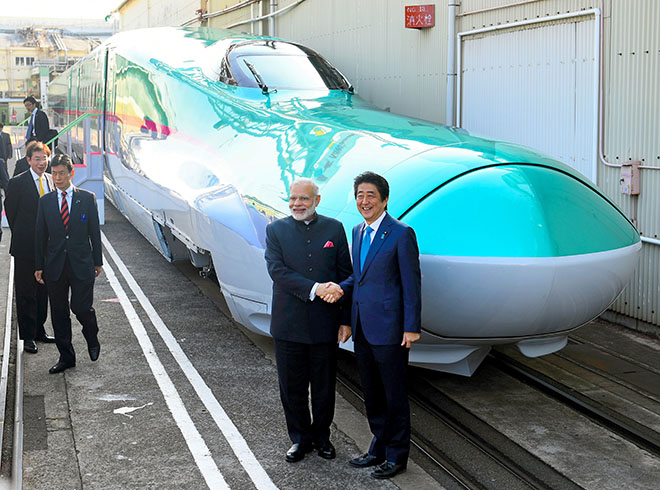By Harshit Dhingra| Senior Correspondent
Bullet trains fall under the category of High Speed Rails (HSR), i.e. railways that have an operational speed of more than 200 km/h. But, unfortunately, despite having one of the largest rail networks in the world, India is yet to have its first HSR. The concept of bullet train in India was first suggested in 1980s by then Railway Minister, Shri Madhavrao Scindia. However, the idea had to be discarded because of the heavy investments that were required to fund the project and the inability of the passengers to meet the higher fares. Nevertheless, after around three decades the leaders of the country realised that bullet trains or HSR were no more a far-fetched reality for India and establishing it in the country was pretty much viable. As a result, Bullet Trains were a highlight of the manifestos of the two main political parties of the country, Bhartiya Janta Party (BJP) and Indian National Congress, during the 2014 Lok Sabha elections.

After BJP came into power, the Union Council of Ministers approved Japan’s proposal to build India’s first HSR in December 2015. The planned rail will run at approximately 350km/h between the financial capital Mumbai and the western city of Ahmedabad. It will cover a distance of about 508km in an estimated three hours. The cost of the project is ₹1.1 lakh crore of which 80% is being financed by Japan at a minimal interest of 0.1% which is to be repaid over 50 years. Though the operation is officially targeted in 2023, the government has announced its intention to bring it into operation a year earlier.
Where bullet trains are renowned for their lightning fast speed, it is not going to be the only contrast between them and the other Indian trains. A plethora of high-class facilities will be provided. To name a few, there will be separate washrooms for men and women, dedicated room for changing and child feeding, a multipurpose room for ailing and nursing mothers, freezer, hot case, LCDs, etc. Moreover, there will be 55 seats for business class along with 695 seats in economy.
However, with every ambitious project comes challenges. Under this project, a major challenge has appeared in the form of protests by farmers in both the states. Concerned farmers have been protesting against the land acquisition by the government for the MAHSR (Mumbai-Ahmedabad High Speed Rail). The farmers allege that the government has diluted the Land Acquisition Act, 2013 by entering into contract with Japan in September 2015. There were even rumours that Japan has stopped funding the project over farmer protests. Soon, NHSRCL (National High Speed Rail Corporation Ltd.), which is responsible for the execution of this project, stepped in and cleared the matter by disqualifying the rumours. According to NHSRCL, out of 1400 hectare of land required, only 0.9 hectare has been acquired so far. In Maharashtra, land owner will get a compensation of five times the market rate and in Gujarat, compensation will be as per the 2016 Act, with 25% premium. It is also alleged that the government data regarding 40,000 daily ridership in 2023 is highly exaggerated to project a favourable number. Moreover, one has to keep in mind that 80% of the funding is being done by Japan which amounts to ₹88,000 crore. Now, it is important to understand that India has a much higher inflation economy than Japan and Indian Rupee is continuously depreciating against Japanese Yen. Hence, with years to come this trend will continue and the 50-year loan may become roughly three times the original price. The governments will come and go and ultimately the burden will fell on the citizens.
Keeping the positives and negatives of the project aside, government is toiling hard to ensure that no compromise is made with the quality. The training centre of the project has been set up in Vadodara which has completed 15-20% of its work. Workers engaged there claim that the work is going on in full swing and they will ensure that all the parameters regarding the project are adhered to. The Japanese trainers will soon be coming to the centre to provide training on how to run the bullet trains, along with highlighting other technical aspects. Moreover, the government is planning to give a push to Come and ‘Make in India’ campaign through this high speed rail project. It is planned that initially 18 sets of such trains will be purchased from Japan but at a later stage India will look to manufacture them itself in Modern Coach Factory in Raebareli, Uttar Pradesh.
Currently, there are two contrasting views in relation to ‘Bullet Trains in India’ and only time will tell whether it turns out to be an asset or liability for the Indian economy.
References:
